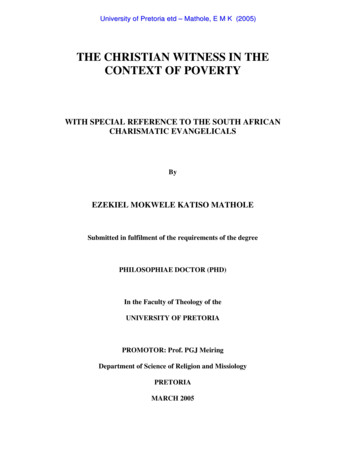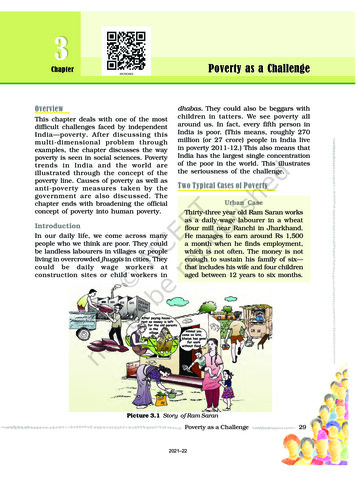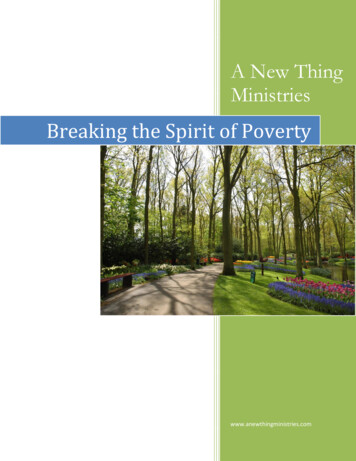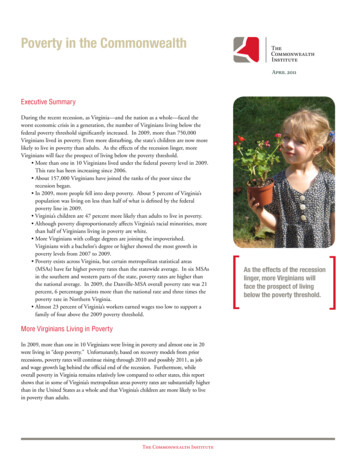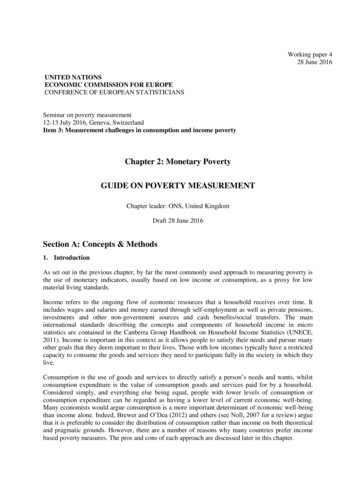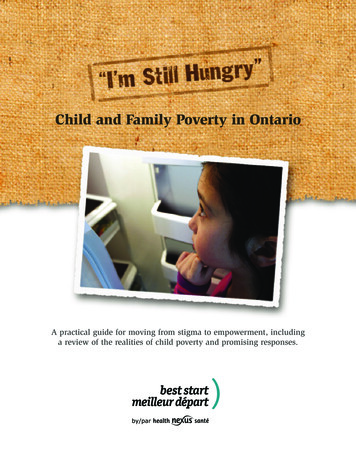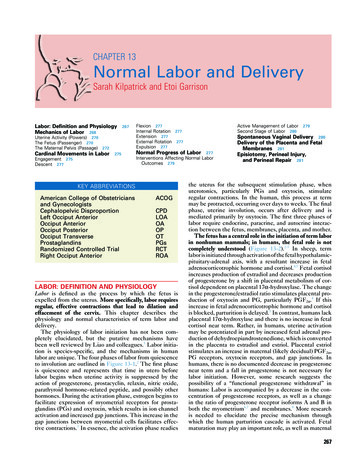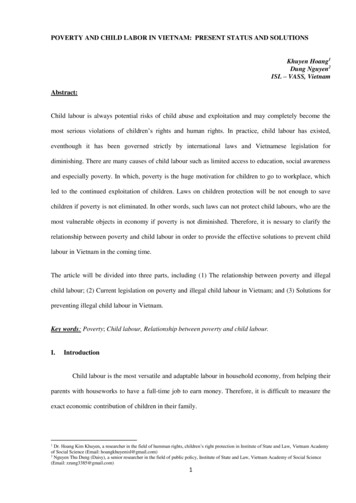
Transcription
POVERTY AND CHILD LABOR IN VIETNAM: PRESENT STATUS AND SOLUTIONSKhuyen Hoang1Dung Nguyen2ISL – VASS, VietnamAbstract:Child labour is always potential risks of child abuse and exploitation and may completely become themost serious violations of children’s rights and human rights. In practice, child labour has existed,eventhough it has been governed strictly by international laws and Vietnamese legislation fordiminishing. There are many causes of child labour such as limited access to education, social awarenessand especially poverty. In which, poverty is the huge motivation for children to go to workplace, whichled to the continued exploitation of children. Laws on children protection will be not enough to savechildren if poverty is not eliminated. In other words, such laws can not protect child labours, who are themost vulnerable objects in economy if poverty is not diminished. Therefore, it is nessary to clarify therelationship between poverty and child labour in order to provide the effective solutions to prevent childlabour in Vietnam in the coming time.The article will be divided into three parts, including (1) The relationship between poverty and illegalchild labour; (2) Current legislation on poverty and illegal child labour in Vietnam; and (3) Solutions forpreventing illegal child labour in Vietnam.Key words: Poverty; Child labour, Relationship between poverty and child labour.I.IntroductionChild labour is the most versatile and adaptable labour in household economy, from helping theirparents with houseworks to have a full-time job to earn money. Therefore, it is difficult to measure theexact economic contribution of children in their family.Dr. Hoang Kim Khuyen, a researcher in the field of humman rights, children’s right protection in Institute of State and Law, Vietnam Academyof Social Science (Email: hoangkhuyenisl@gmail.com)2Nguyen Thu Dung (Daisy), a senior researcher in the field of public policy, Institute of State and Law, Vietnam Academy of Social Science(Email: zzung3385@gmail.com)11
In practice, the advent of industrial revolutions led to child labor exploitation. The image of a boysuffocating on a chimney, or a small hand working at the relentless pace of a machine have becometypical images of child labor exploitation3.By the 19th and early 20th centuries, this was the time which began to a profound change in therole of children in modern society. It is “There is no place for child labour in society. It robs children oftheir future keeps families in povery”4. In other word, poverty is considered the main problem to lead totheir participation in economic activities and thereby leading to child labour in early stage. When childrenwork early, it means that childre have to use most of their time to work instead of studying, playing, andentertaining. Generally, they have to face labor exploitaion with working for long hours per day andoverloading their means. Especially, in economic market where labor capacity becomes a commodity,children are always the target of labor exploitation by profiteers.Therefore, in above context, clarifying and evaluating the relationship between child labor andpoverty is necessary for the purpose of offering solutions to contribute to preventing child labor. It alsohelp countries to achieve Sustainable Development Goal (SDG) 8.7 through actions to eliminate childlabor, particulary the context of Covid-19 pandemic has cause more serious poverty in the world,including Vietnam.II.The relationship between illegal child labor and povertyChild labor is generally defined as work that deprives children of childhood, their potential andtheir dignity and that is harmful to a child’s physical and mental development. It often refers to work thatis harms or is likely to cause physical, mental, moral and social harm to a child; interferes with children'sschooling by keeping them out of school, forcing them to leave school early, require them to try to studywhile doing excessive long and heavy work5. In other words, child labor often refers to any work that3Colin Heywood, Child labor, accessed at April 19, es/Publicinformation/Pressreleases/WCMS 766376/lang--vi/index.htm, accessed at Feb 12, 2021.5International Program Elimination of child labour (2004), Child labour a texbox for university student, Geneva, page 16.2
deprives children of their childhood, potential and dignity and is harmful to their physical and mentaldevelopment is child labor6.Currently, child labor has been and is a burning problem in most developing countries. Accordingto estimates of the International Labor Organization (ILO), in the world, there are about 152 millionchildren (about 64 million girls and 88 million boys) from 5 to 17 years old who are engaged in labor,accounting for nearly one-tenth of all children in the world7.In particular, in terms of industry structure, child labor is concentrated mainly in the agriculturalsector (accounting for 70.9%), nearly one-fifth of child laborers working in the service industry(accounting for 17.1%), and 11 .9% of child laborers working in other industry. Africa is the continentwith the largest proportion of child laborers, account for 73 million child laborers8; and 62,1 million inAsia Pacific area9. Thus, the data show that the rate of child laborers being abused is still high,particularly in the cases of heavy work even though countries are constantly making efforts to prevent andgradually eliminate them and the rate of child labor has tended to decrease in the last 20 years10.However, the context of the COVID-19 pandemic currently is threatening the achievements ofchild labor protection over the years. In addition, child labor is cheap and many children are still willingto participate in labor market. These make the use of child labor fully utilized by employers. According toevaluation of ILO, United Nations International Children’s Emergency Fund (UNICEF), and manycountries11, child labor often originates from many causes such as the lack of suitable jobs for adults; lackof social protection and failure to ensure that all children attend school of the minimum age; limitedawareness of parents, children, employers particularly poverty. Such as, poverty is one of the mainreasons for children being forced to work and poverty, inadequate education are important barriers in the6Asia tops child labor and human trafficking activity, ps-child-labor-and-human-traffickingactivity, accessed at April 12, 2021.7Child labour and exploitation, ction/child-labour-and-exploitation, accessed at April urces/Publicinformation/newsitems/WCMS 575539/lang--vi/index.htm, accessed at September 19,2017.9Reaching SDG Target 8.7 on Eradicating Forced Labour,Human Trafficking and Child Labour, /09/Regional-Conference-for-Asia.pdf, Kathmandu,20-22 November 2019, accessed at April 12, ces/Publicinformation/Pressreleases/WCMS 766376/lang--vi/index.htm, accessed at Jan 15, 202111 Child labour and the youth labour market in 1/file/Child%20Labour%20Policy%20Brief%20.pdf, accessed at April 12, 2021.3
abolotion of child labor12. The relationship between child labor and poverty can be seen with someaspects as follows:Firstly, poverty is the main cause of child labor and child labor abusement. Basically, poverty isunderstood as the lack of resources to provide the necessities of life such as food, clean water, shelter,utensils, and people’s ability to access basic social services13. Therefore, poverty and its potential riskfactors are identified as factors that are damaging the physical and cognitive health of children and theirfamilies14. It can be affirmed that child labor originates from the vicious circle of poverty. Poor parentsare forced to send their children to work instead of school. In reality, the opportunity cost of going toschool is quite high and poor parents cannot afford to pay tuition fees, plus living in poverty does nothave access to quality education. Therefore, sending children to school is not an attractive option thatpoor families need instead of forcing them to work. In other words, poverty robs children of their mostbasic rights, from the right to enjoy in the best living and development conditions, the right to foster carefor comprehensive development, the right to live with parents and be protected, cared for and educated bytheir parents. to the right to education, learning, entertainment, health care, social security assurance, theright to be protected from exploitation of labor, not premature labor.In fact, with more than 1.2 billion children globally facing one of three major threats: poverty,conflict and discrimination, up to 153 million children face to all three of these threats. Poverty alsoleaves 6 out of 10 children globally without access to health and social security services, making thembecome the most vulnerable groups to the risk of falling into chronic poverty. This is the result of aninvestigation by Save the Children which surveyed and published in 201815. Therefore, to reduce childlabor and poverty reduction, ending poverty is the key16. Ending global poverty is one of the top prioritiesthat the world vision has been set out in the 2030 Global Sustainable Development Goals, which sets thegoal of eradicating extreme poverty for all. everyone everywhere.12Child labour and domestic work, /lang--en/index.htm, accessed at April 12, 2021.Global poverty: Facts, FAQs, and how to help, es/global-poverty-facts, accessed at April13, px15Hơn 12 tỷ trẻ em trên thế giới bị đe dọa bởi các nguy cơ nghèo đói, xung đột hoặc biệt biệt đối xử, -485791.html, accessed at May19, 2021.16Zahid Naeem , Faiza Shaukat và Zubair Ahmed ,Child labor in relation to poverty , 57/,accessed at April 12, 2021.134
Second, child labor contributes to increasing poverty. Child labor is most prevalent in developingand least developed countries (LDCs). Accordingly, poverty is the driving force that children have towork, and the child’s income from work is considered very important for the survival of themselves andtheir families. In addition, heavy, hazardous and dangerous jobs may harm the health, safety and moralityof children; and leave them to fall into situations to be abused of physics, psychology or sex. In thissituations, children may become depressed and difficult to participate in labor maket as well as intergrateinto society. In addition, early labor causes children to drop out of school early or have a decline inlearning. The above problems will increase poverty for children and their families as well as creatinggreat obstacles, negatively impact into national human resources in general. Therefore, there is a need forregulation on the effective elimination of child labor and a ban on the worst forms of child labor. Withoutefforts to reduce poverty, without addressing the deprivations that children are facing, we will hardly beable to end poverty.III.Current Regulations and Practices on illegal child labor and poverty in VietnamChildren and child labor are always the top concern of the Communist Party, Vietnamgovernment, society and every family in Vietnam. Vietnam has promulgated many legal documents andpolicies for children, participated in ratifying international treaties to ensure children’s rights, andpreventing and reducing child labor. It can be said that Vietnam is one of the countries in the world and inthe ASEAN region that actively participates in and ratifies international treaties and promulgates manylegal documents and policies to ensure poverty alleviation and poverty reduction in order to promotehuman rights, including children’s rights. Through this policies, Vietnam has laid the legal foundation foreffective and sustainable anti-child labor action from the 1990s to the present.Up to now, Vietnam has ratified 25/190 ILO conventions, including 7/8 basic internationalconventions17 and there are 5 Conventions directly related to child labor, including (1) the Convention onthe Rights of the Child (CRC) dated on November 20, 198918. Vietnam was the first country in Asia andthe second in the world to ratify the United Nations Convention on the Rights of the Child on February17International Labor Standards, l-labour-standards/lang--vi/index.htm, accessed at April15, 2021.18Convention on the Rights of the Child, s/crc.aspx accessed at April 15, 20215
20, 1990, and the Convention entered into force in Vietnam on February 20 December, 199019. With thisConvention, Vietnam recognizes the rights of children and demonstrates its commitment to ensuring therights of all children, ensuring a better future for all children. (2) On November 17, 2000, Vietnamratified ILO Convention No. 18220 on the prohibition and immediate actions to eliminate the worst formsof child labor signed on June 18, 199921. It considers that the effective elimination of the worst forms ofchild labor requires immediate and comprehensive actions, taking into account the implications of freebasic education system and the necessary to remove the children involved from all the worst jobs and helpthem recover and reintegrate into society. (3) ILO Convention No. 138 on the minimum age ofemployment, adopted by the ILO on July 26, 197322. Vietnam ratified on July 24, 200323. As required bythe Convention, Vietnam has determined the age of children, the minimum age for work and establishednational policies on the abolition of child labor. (4) the Convention No.29 of ILO on Forced Labour193024, Vietnam joined in 2007. (5) The Convention No.105 on Abolition of Forced Labour Convention,1957)25, Vietnam ratified on July 08, 2020. Together with the Convention No.29, Vietnam’s ratification ofthe Convention No.105 will contribute to preventing the risks of forced labor, protecting the legitimaterights and interests of workers, including children, helping to a stable and harmonious workingenvironment, thereby positively affecting labor productivity, helping Vietnamese goods have morefavorable conditions in accessing international markets, especially the international market such as EUand US markets, thereby helping the economy to develop sustainably and ensure better social justice inthe context of globalization. Thus, with the accession and ratification of international conventions relatedto poverty and human rights in general and child labor rights in particular, Vietnam deeply demonstratesthe international legal responsibility of a -1989-3356, accessed at April 15, ung-hinh-thuc-lao-dong-tre-em-toi-te-134, accessed at April 15, 2021.21C182 - Worst Forms of Child Labour Convention, 1999 (No. 182),https://www.ilo.org/dyn/normlex/en/f?p NORMLEXPUB:12100:0::NO::P12100 ILO CODE:C182, accessed at April 15, 2021.22C138 - Minimum Age Convention, 1973 (No. 138), https://www.ilo.org/dyn/normlex/en/f?p normlexpub:12100:0::no::P12100 ilo code:C138,accessed at April 15, 1973-viet-nam-phe-chuan-ngay-2462003-137, accessed at April 15, 2021.24C029 - Forced Labour Convention, 1930 (No. 29), https://www.ilo.org/dyn/normlex/en/f?p 1000:12100:0::NO::P12100 ILO CODE:C029, accessed atApril 15, 202125C105 - Abolition of Forced Labour Convention, 1957 (No. 105), https://www.ilo.org/dyn/normlex/en/f?p 1000:12100:0::NO::P12100 ILO CODE:C105,accessed at April 13, 2021.6
In addition, the policies and laws of Vietnam related to the prevention and reduction of childlabor is gradually being improved and harmonized with international standards. On June 7, 2016, thePrime Minister issued the Decision No.1023/QD-TTg approving the program on prevention and reductionof child labor for the period 2016-2020 with the overall objective: “effective prevention and reduction ofchild labor; Children at risk and children working in contravention of the law are detected, intervenedpromply and supported to integrate into the community and have the opportunity to develop”. This is ademonstration of the political determination of Vietnam for a better future for children, not lettingchildren fall into poverty and not allowing child labor to exist.In addition, Vietnam domesticated international commitments on child labor in the Labor Code2019, the Law on Children 2016, the Criminal Code 2015 (amended and supplemented in 2017), the Lawon Anti-trafficking 2011 For example, the Convention No.138 and the Convention No.182 stipulatethat the minimum working age must not be less than 15 years old. Children under the age of 18 are notallowed to do dangerous work. Children between the ages of 13 and 15 can work without compromisingtheir health, development and learning. It also prohibits the use of children under the age of 18 in theworst forms of child labor. Vietnam internalizes these commitments in the 2019 Labor Code, the TradeUnion Law and other regulations related to the Convention No.138 and the Convention No.182.Although the Vietnamese law is relatively completed, the implementation of current regulationson prevention and reduction of child labor is a challenging issue in Vietnam because poverty isconsidered the main cause to force children to participate in labor market early that lead to child laborobivioulsy. Some detail as follows:The lack of legal definition on child laborThe legal document system of Vietnam does not have a legal definition of child labor althoughthere are many regulations related to child labor. Clause 1, Article 37 of the Constitution stipulates that “Itis strictly forbidden to infringe, torture, mistreat, neglect, abuse, exploit labor and other acts that violaterights children”. The Labor Code (amended in 2019) was passed to strengthen the protection of workers,including juvenile workers. Section 1 Chapter XI already contains regulations related to juvenile workers7
such as the principles of using juvenile workers (Article 144); employing people under the age of 15 towork (Article 145); working hours of juvenile workers (Article 146); jobs and workplaces that prohibitusing workers from full 15 years old to under 18 years old (Article 147). In addition, there are severalother codes and laws such as the Law on Vocational Education 2014 on strengthenning vocationaltraining for students who have left school as well as young people who have already had jobs; Article 296on the crimes of violating regulations on the use of employees under 16 years of age of the Penal Code2015 (amended and supplemented in 2017) which stipulates those who employ people under 16 years oldto do heavy and dangerous jobs or exposure to hazardous substances according to the list prescribed bythe law, shall be fined or subject to non-custodial form or imprisonment; The 2015 Law on OccupationalSafety and Health and some circulars specifying the list of jobs and workplaces where the employment ofchild labor is prohibited; providing the work categories that employ juvenile workers under 15 years old.In particular, the 2016 Law on Children stipulates prohibited forms of child exploitation, includingforcing children to work to gainst the labor law, clearly stipulating the responsibilities of ministries, massorganizations, family, community, social organizations, economic organizations in the prevention andreduction of child labor. These are specific regulations on the age of children allowed to participate inlabor market; jobs and workplaces where the employment of juvenile workers is prohibited and the actsthat violate or infringe on children’s rights.In general, above provisions are consistent with the conventions that Vietnam ratified, inparticular, two ILO conventions, including the Convention No. 138 of 1973 on the minimum age for workand the Convention No. 182 of 1999 on the prohibition and urgent action to eliminate the worst forms ofchild labor. However, in order to determine exactly when a work performed by a child is considered aschild labor, or to identify that not all work performed by a child is child labour, it is necessary torecognize the legal definition of child labor in legal documents.The challenges in implementation of regulations on prevention and deduction of illegal childlaborCurrently, according to the provisions of Article 1 of the Law on Children 2016, a child is aperson under 16 years of age. Meanwhile, the Labor Code 2019 defines, an employee is a person who8
works for an employer under an agreement, is paid a salary and is subject to the management,administration and supervision of the employer. Therefore, it can be understood that a child laborer is aperson under the age of 16 who works for an employer under an agreement, is paid a salary and is subjectto that person's management, administration and supervision. In addition, the Labor Code 2019 stipulatesthat the minimum working age of employees is 15 years old, except for some special cases, employeesunder 15 years old may be employed but must also meet the certain requirements. Therefore, childrenaged 15 and over must have adequate requirements such as education and health to work. Of course, laborat any age must also comply with the provisions of the law such as not working at night, not working 8hours per day and not doing prohibited jobs, etc However, implementation of regulations on preventing and minimizing the risk of illegal childlabor currently faces many difficulties such as unclear awareness, capacity and coordination betweenagencies, sectors, relevant social organizations, local authorities, organizations of workers and employers,the media, as well as children, their families and the community; not being ensured working conditionsand occupational safety and health; not being timely in propaganda and dissemination of the provisions ofthe law related to child labor (not using children or using children but complying with the provisions ofthe law); not been able to support poor children to participating in vocational training or schoolingopportunities26.Moreover, there are still many enterprises which contribute to the increase of illegal child laborthrough several actions such as employing children under the minimum working age, but for heavy workor businesses activities contribute to pollution of river water leading to mass fish deaths, causing farmersto lose income and have to force their children to make up additional income or some violations related tobusiness activities, products or services through the conduct of business partners (For example:Embroidery details on clothing of a fashion brand are outsourced by the supplier from households whichemploy children or purchase directly or through agents of raw materials and agricultural productsILO, Phòng ngừa và xóa bỏ lao động trẻ em ở làng nghề truyền thống chế tác gỗ và đá mỹ nghệ (Tài liệu hóa mô hình tiềm năng ở xã HiềnGiang, huyện Thường Tín, thành phố Hà Nội, s 463105.pdf accessed at April 15, 2021269
produced by child labor. This is a violation of the processing contract and is prohibited by the policy ofthe retail brand)27.In reality, according to the National Survey of the Ministry of Labour, Invalids and Social Affairs(MOLISA), the ILO and the General Statistics Office, Vietnam currently has 1.75 million child laborers,accounting for 9.6% of the total number of children28. In which, 85% of children live in rural areas and15% live in urban areas. Child labor is mainly concentrated in three occupations, including agriculture,service, and construction. In which, agriculture accounts for the highest proportion, nearly 1.18 millionchildren (accounting for 67%). The number of children working in occupations that are prohibited fromusing underage labor or with hazardous working conditions is 1.3 million children (accounting for 75% ofchild laborers)29. In addition, only 45.2% are still attending school, 52% have dropped out and 2.8% havenever attended school30. The working time was forced by the employer from 11-12 hours, even up to 16hours/day, an average of 42 hours/week31. Many child workers under the age of 15 have to do anything toearn money, and have to work in an unsafe environment and conditions with very cheap salary. Forexample, the salary of child laborers serving at restaurants is often from 1.8 to 2 million VietnameseDong per month32.The main cause of the situation is due to poor status and economic difficulties. Parents areilliterate and do not care about their children’s lives, as well as parents’ awareness of the harmful effectsof child labor is low. Children who cannot afford to go to school are forced to go to work early whichlead to drop out of school or get bored of school. There still exists labor market with cheap price,Tổ chức lao động quốc tế (ILO), Phòng Thương mại và Công nghiệp Việt Nam (VCCI), Hướng dẫn phòng ngừa và giảm thiể lao động trẻ emdành cho doanh nghiệp, ms 721942.pdf,trang 16-17.28Xóa bỏ lao động trẻ em cần sự chung tay từ nhiều phía, -chung-tay-tu-nhieu-phia39388.htm, accessed at June 28, 2019.29Ngăn ngừa tình trạng lao động trẻ em, tinh-trang-lao-dong-tre-em-361958/, accessed atJune 17, 2019.30Xóa bỏ lao động trẻ em cần sự chung tay từ nhiều phía, -chung-tay-tu-nhieu-phia39388.htm, accessed at June 28, 2019.31Ngăn ngừa tình trạng lao động trẻ em, tinh-trang-lao-dong-tre-em-361958/, accessed atJune 17, 2019.32Tỷ lệ lao động trẻ em Việt Nam trong độ tuổi từ 5 - 17 tuổi thấp hơn 2% so với tỷ lệ trung bình của khu vực Châu Á và Thái Bình i-tu-5-17-tuoi-th.html, accessed at December 28,2020.2710
disorganized; in some cases employers tend to hide child labor by setting up business at remote areas suchas craft villages, fishing areas, seafood processing, quarrying, begging, porters, or small farms.33).These reasons not only affect the health and psychology of children, but also affect the future ofchildren. In the long term, children do not have the opportunity to comprehensive develop, having adecent work which lead to fall into the cycle of poverty. In other words, early labor affects children’sright to access to education, making them not have the opportunity to learning and developing ageappropriate personality. These situations make children face to the risk of exploitation, abusement, eventrafficking and violence. In addition, the use of illegal child labor have many unintended consequencessuch as negatively impacting the physical and psychological development of children, as well asshindering access to education, affecting human resources in the future.IV.Some solutions to prevent illegal child labor in VietnamVietnam has made a lot of efforts related to the prevention and reduction of child labor such asperfecting laws and policies to effective implementation of programs and projects from central to locallevels, from government agencies, sectors, organizations and social communities. Therefore, in order toprotect children’s rights and solve the problems of illegal child labor, some measures should be taken asfollows:Firstly, it is necessary to recognize and define the concept of “child labor” in legal documents.The aim of the regulation is clarifing the legal discrimination of child labor. Normaly, childrenparticipating in age-appropriate work should be encouraged to enhance life skills. However, if childrenparticipate in housework for a long time, from 10 to 12 hours, including dangerous and toxic jobs thatHãy để trẻ em nuôi dưỡng những ước mơ, ao-dong-tre-em/, accessed at April 15, 2020.For example, at seafood processing facilities in coastal communes of Dien Chau district, Nghe An provinc, on summer days or weekends whenchildren don't have to go to school, they go to shrimp and fish fillet processing establishments to apply for part-time jobs and earn money forpersonal expenses. The main job at these establishments is to steam shrimp, peel it for drying, the shell after peeling is collected and weighed topay, workers receive about 10,000 VND/kg. If you work hard, each person can earn several hundred thousand a day. “Works such as peelingshrimp, scraping fish scales and fillets are not heavy and have an attractive income, so
ISL - VASS, Vietnam Abstract: Child labour is always potential risks of child abuse and exploitation and may completely become the most serious violations of children's rights and human rights. In practice, child labour has existed, eventhough it has been governed strictly by international laws and Vietnamese legislation for
